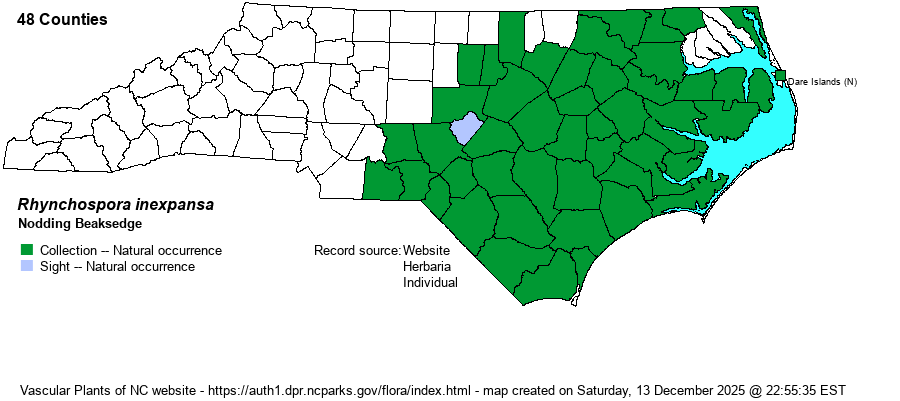| Author | (Michaux) Vahl | |
| Distribution | Throughout the Coastal Plain, Sandhills, and lowermost Piedmont. Curiously rare on the Outer Banks.
Coastal Plain, southeastern VA to northern FL to eastern TX, southeastern OK, and southern AR. | |
| Abundance | Common in the Coastal Plain, rare to uncommon in the lower Piedmont. Often occurs in populations of hundreds of plants. The State Rank is surely S5, as opposed to S4?. | |
| Habitat | Originally in moist or seasonally moist pine savannas, flatwoods, sandhills, and estuarine fringe forests; but with disturbance has colonized roadsides, logging decks, woodland clearings, ditches, and powerlines -- usually where damp or wet. | |
| Phenology | Flowering and fruiting July-September. | |
| Identification | Nodding Beaksedge is often noticed because it may form rather dense groups of plants. Individual stems are normally 2-4 feet tall, but upper halves almost always arch over, causing some/most spikelet clusters to droop. The seeds are unique in having a narrowly elliptical body and a long tapering beak. It is likely to be found in disturbed places as opposed to pristine natural areas. | |
| Taxonomic Comments | None
Members of the genus Rhynchospora -- mainly called beaksedges but also called beakrushes -- are mostly Coastal Plain in distribution and are important members of our longleaf pine savannas, flatwoods, streamheads, depression ponds, Carolina bays, and beaver ponds. They vary from small and wiry to large and coarse. Keys concentrate on features of the achenes (seeds) and the shape and arrangement of the flower clusters (spikelets). The seeds may or not have bristles at their base; bristle number, length, and toothing are critical characters. Size and shape of the seed beaks is also critical. The drawings in Godfrey & Wooten (1979) are extremely helpful. The genus now includes Dichromena, the white-topped sedges. | |
| Other Common Name(s) | None | |
| State Rank | S4? [S5] | |
| Global Rank | G5 | |
| State Status | | |
| US Status | | |
| USACE-agcp | FACW link |
| USACE-emp | FACW link |

